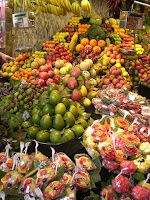I have two perfume websites, the older one with a local
hosting company, iEasySite, and a newer one on Shopify. Both of these websites,
as well as my orchid nursery website, have a built-in e-mail feature. However,
checking three clunky e-mail programs multiple times a day would be
unnecessarily labor-intensive, so I have all mail from these addresses
forwarded to a single gmail account that works quite efficiently, and from
which I conduct all of my business.
My local website host leaves me alone, so my only
communication with them happens when I contact them because of a problem. They
are always very responsive, but then go back to their hands-off management
strategy, which is how I prefer it.
Shopify, on the other hand, regularly sends me unsolicited
e-mail “newsletters” with what they seem to think are helpful hints about how
to run an online business. After reading a number of these, I can’t help concluding
that Shopify caters to people who have absolutely no experience running a
business, online or otherwise, who are simply trying to sell stuff as a hobby,
who are running some sort of marginal business reselling other companies’
products, or who are trying to establish an online business so that they can
quickly sell it to someone else. Most of them seem to deal in T-shirts.
Some of the hints may be slightly useful, especially for
those with zero experience, but a lot of the others are what I consider really bad
advice. I’m just going to consider two
of them here. On a regular basis Shopify warns people that if they use a gmail
address they will be perceived as “unprofessional”. They justify this statement
by saying that “anyone can get a gmail address”. What? Can’t anyone get a
Shopify website? I don’t remember having to present any qualifications other
than the ability to pay a few dollars a month. Anyone can do that. In fact,
anyone can get a website or an e-mail account from any service that provides them,
no questions asked.
Over the past few years, gmail has become the most
convenient e-mail system to use, even for business, especially if one runs
multiple branches of a business and wants to consolidate the output of multiple
e-mail accounts into one. My prediction is that more and more businesses will
forego the “support@yourname” e-mail systems and go to “yourname@gmail”. After
all, it’s ultimately the quality of customer service and communication that
counts toward a “professional” image, not the form of the e-mail address. However,
in case my perception is wrong, which it could be, I’ll pose the question to
you readers: Do you think using a gmail address makes a business look
unprofessional?
The other day I received another “newsletter” from Shopify advising
people not to ship items in standard brown cardboard boxes or plain bubble
mailers because everyone wants a spectacular “unpackaging experience”. OK, I
know how exciting it always is to receive a package in the mail, but is the
excitement due to the appearance of the shipped package itself or the
anticipation of what’s inside? Is it really better to wrap the outer package in
bright colored, metallic, sequined materials, tie it with ribbon, and paste
hearts and unicorn stickers all over it? Or make your package look like a
velvet tuxedo with a satin collar and bow tie? Or ship an ugly t-shirt in a big
metal canister that looks like an oil drum? Or ship a package of tea bags in a hand-carved
wooden box sealed with sealing wax and sporting a calligraphy handwritten
address?
I actually have had customers who ask me to be sure to ship their
perfume in a plain brown box because they have received some of those gaudy,
glittery special-interest packages in the mail and found them embarrassing. If
nothing else, too much elaborate outer packaging is wasteful. The purpose of
outer packaging is to protect whatever is inside from the bashing that
inevitably occurs as the poor little package is tumbled and smashed with
millions of others like it or bigger and heavier than it is. Can’t people wait to
see the nice packaging on the inside after they’ve ripped away the outer
protective layers? Again, I’ll post the question to you readers: Do you enjoy
getting special external packaging even when the goods inside are wrapped and
packaged nicely? Would you be willing to pay more for merchandise in order to cover the cost of fancy shipping boxes and mailers, which can get quite pricey?
I guess the bottom line of all this is that Shopify seems to
think that everyone focuses entirely on factors that are completely superficial,
and that no one cares about quality of goods or service as long as the delivery
is flashy. A bad meal delivered to your doorstep by a musical drone with a
pulsating laser light show, anyone? Maybe that’s what the world is coming to, but if so,
it’s sad.
[Images are taken from various retailers' websites.]

























